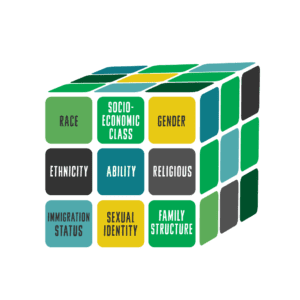مضمر تعصب
تعلیم میں ساختی نسل پرستی اور امتیاز کو اچھی طرح سے دستاویز کیا گیا ہے۔ معذوری اور دیگر سماجی شناختوں جیسے نسل اور جنس کے باہمی تعلق کے بارے میں کم تحقیق موجود ہے۔ تاہم، یہ موضوع آئی سی ٹی کلاس رومز کے اندر متحرک کی ہماری سمجھ کے لیے بہت اہم ہے۔
One of the reasons that the intersectionality of disability and other social identities is less researched may be that within the educational systems, decision-makers who usually have a lot of discretion often believe that they are acting objectively based on facts. However, research shows that مضمر تعصبات—that is, attitudes or stereotypes that affect our understanding and actions in an unconscious manner—exist in all aspects of education and disability diagnosis (identification, placement, and discipline).
Racial Implicit Bias and Disability Diagnosis
 دیکھیں: Why Is Disability Representation So White?
دیکھیں: Why Is Disability Representation So White?
(Note: The presenter speaks quickly, particularly during a montage within the video. You can press the settings icon on the bottom right-hand corner of the screen to choose a slower playback speed.)
Racial bias and white supremacy can lead to misdiagnosis, over-diagnosis of specific types of disabilities, and under-diagnosis of others. اس مضمون میں سفید بالادستی کی ثقافت کے بارے میں مزید پڑھیں.
Studies have shown that Black and other minority students are
- more likely to be misdiagnosed;
- more likely to be educated in restrictive environments as opposed to the least restrictive environment called for by the Individuals With Disabilities Act (IDEA);
- likely to be over-diagnosed in high-incident categories of disability (which are more subjective) and under-diagnosed in low-incident categories (which are more objective).
غیر متناسب طور پر زیادہ تعداد میں سیاہ فام طالب علموں کی ساپیکش معذوری کی تشخیص بمقابلہ معروضی تشخیص اس بات کا واضح اشارہ ہے کہ کس طرح مضمر تعصب طالب علم کی معذوری کی تشخیص کا سبب بن سکتا ہے۔
Gender Bias and Disability Diagnosis
تشخیص میں مضمر تعصب کی ایک اور مثال میں، تحقیق سے پتہ چلتا ہے کہ خواتین کو اکثر طبی تحقیق سے خارج کر دیا گیا ہے اور اکثر ان کی غلط تشخیص کی جاتی ہے۔ اس کی ایک عام مثال خواتین میں آٹزم کی کم تشخیص ہے، جو تحقیق کی کمی سے منسلک ہے۔
“The percentage served under IDEA who received services for autism was higher for male students (13 percent) than for female students (5 percent).”
—قومی مرکز برائے تعلیمی شماریات
Author Maya Dusenbery spoke at the Society to Improve Diagnosis in Medicine Conference about the impact of implicit bias on women’s health stemming from two major gaps: a “knowledge gap” and a “trust gap.” In the article “Women More Often Misdiagnosed Because of Gaps in Trust and Knowledge,” Liz Seegert shares Dusenbery’s ideas from the conference. Dusenbery explained, “There’s a general lack of knowledge about women’s symptoms, bodies, and conditions that disproportionately affect them. That’s the legacy of decades of women being underrepresented or excluded from the research.”
Dusenbery went on to note that “there’s a lack of trust in women’s self-reports about what they’re experiencing, and a tendency to dismiss or psychologize complaints. That is part of the broader cultural stereotypes about women, and in particular, the ہسٹیریا کا تنازعہ، whose explanations ranged from a ‘wandering womb’ to demonic possession to witchcraft. Once Freud entered the picture at the end of the 19th century, hysteria became a catch-all psychological explanation for these unexplained complaints, which manifested as physical symptoms.”
Implicit Bias and Consequences in the Classroom
ایک بار جب طلباء کی تشخیص ہو جاتی ہے تو اس کے نتائج بھی ہوتے ہیں۔ مثال کے طور پر، تشخیص شدہ معذوری والے طالب علموں کو معطل اور نکالے جانے کی شرح بہت زیادہ ہے۔
“Nearly 75 percent of special education students were suspended or expelled at least once.”
—Dustin Rynders, “Battling Implicit Bias in the IDEA to Advocate for African American Students With Disabilities”
Keeping in mind that during the 2018–19 school year, more than seven million students in the United States of America received special education services, we can begin to sense the grand scale of implicit bias and lack of awareness of how intersectionality can impact students with disabilities in ICT classrooms. Often the implicit biases held by classroom educators and administrators can compound upon one another, which can have consequences beyond students’ K-12 education.
Going back to the analogy of the Rubik’s Cube, consider that this resource has only cited very briefly how implicit biases often play out in diagnosis and treatment with two of so many possible identities.
 سیکھیں
سیکھیں عکاسی کرنا
عکاسی کرنا دریافت کریں۔
دریافت کریں۔



